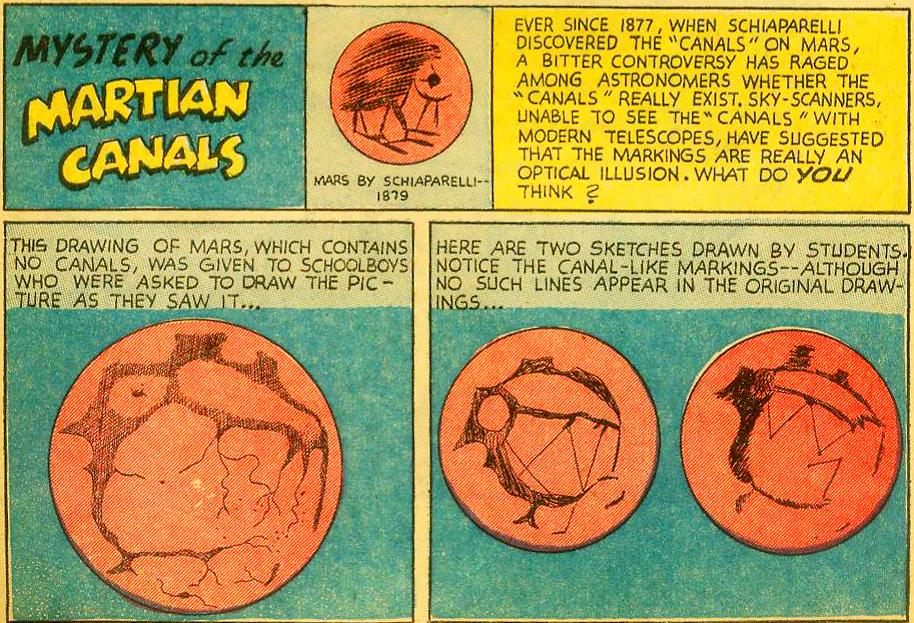Strange Adventures (1950-1964)

#1
2 (oct.1950) Escape from Mars (text)
3 (déc. 1950) The Strange Fate of Adolph H.
6 (mars 1951) The Confessions of a Martian
9 (juin 1951) The Exile of Space
18 (mars 1952) One-Way Trip to Mars
23 (août 1952) The Ghost Planet
24 (sept.1952) the Martian Joke
26 (nov.1952) Mars-On Channel 8
31 (avril 1953) Lights, Camera -- Invasion!
33 (juin 1953) The Snows of Mars
36 (sept.1953) Man into martian
42 (mars 1954) I Delivered Mail From Mars!
49 (oct.1954) Mars on Earth
52 (janv.1955) The Mystery of the martian canals
53 (janv.1955) Martian Masquerade
55 (avril 1955) Movie Men from Mars
64 (janv.1956)The Maze of Mars
65 (fév.1956) The Rock-and-Roll Kid from Mars
67 (avril 1956) The Martian Masquerader
69 (juin 1956) The Museum from Mars
70 (juil.1956) Menace of the Martian Bubble
73 (oct.1956) Science Fiction Convention on Mars
82 (juil.1957) The Man Who Inherited Mars
87 (dec. 1957) Meteor Menace from Mars
90 (mars 1958) The Day I Became a Martian
94 (juil. 1958) Secret of Planetary Cones!
95 (août 1958) The Martian Barrier ; The Boy who saved the solar system
103 (avril 1959) 3 Gifts for Mars
108 (sept.1959) The Martian Earth-Trap
114 (mars 1960) The Case of the Martian Witness (Star Hawkins)
152 (mai 1963) The Martian Emperor of Earth
155 (août 1963) Prisoner Of The Undersea World! ; Prisoner Of The Green Planet!
159 (dec. 1963) Yes Virginia -- There is a Martian
174 (mars 1965) I Was a Living Treasure
176 (mai 1965) The Case of the (martian) Cosmonik Quartet
182 (nov.1965) The Case of the blonde Bombshell (Star Hawkins)
228 (janv-fév. 1971) The Hothouse World!
Chris KL-99: The Menace of the Green Nebula (1950) Writer: Edmond Hamilton.
Art: Howard Sherman.
The first story about space explorer Chris
KL-99. Chris explores the universe with two close friends: Halk,
a giant Martian adventurer, and Jero, a small green Venusian scientist.
These color choices are appropriate to the two planets, as people
thought about them then: Mars was a place of red deserts, while
Venus was green, wet and fertile. The two personalities of the
aliens also seemed appropriate: Mars was silent, vast, noble and
forbidding, like Halk, while Venus was friendly, good humored
and intellectual, like Jero They also have an alien pet, Loopy,
a dog like animal who changes colors according to his emotions.
There is plenty of sense of alien adventure right here among the
crew, with friends from four worlds. Hamilton's series loves alien
beings. They are regarded as friends, and meeting people from
another species is considered the greatest experience anyone can
have. It is hard not to see symbolism here about race relations,
and a suggestion that diversity of races is good.
Chris has a mission from the government: "to discover and
explore new worlds and protect their inhabitants". The universe
of the future is filled with rapacious merchants who would like
to loot newly discovered planets of their natural resources, and
exploit their inhabitants. It is the job of Chris and his crew
to prevent this.
Chris KL-99:
The Exile of Space (1951) Writer: Edmond Hamilton.
Art: Murphy Anderson.
shows Halk's
back-story.
We learn the secret, tragic background of Chris'
companion, Halk the Martian. Halk is that familiar Hamilton character,
the ostracized outsider, trying to prove his worth to society
at large.
The Confessions of a Martian (1951) Writer: Manly Wade
Wellman. Art: Curt Swan. Wellman's works tend to be crime stories,
wrapped in a science fictional context. This is a spy tale, with
Earth and Mars substituted for such nations as Britain, Germany
and Russia in the traditional spy story. The story ends with a
plea for peace on Earth - a subject that will return in Wellman's
"The Other Earths" a few issues later.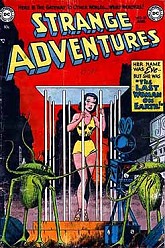 The Ghost Planet (1952) Writer: Gardner Fox. Art: John
Giunta.
The Ghost Planet (1952) Writer: Gardner Fox. Art: John
Giunta.
A human spaceman lands on Mars, but it seems mysteriously
and recently deserted, in the manner of the real life mystery
ship Mary Celeste. This little story (just 4 pages long)
is notable for Giunta's outstanding art. It creates a whole picture
of an advanced Martian civilization. We see gracious, futuristic
streets, and the interiors of homes. They remind one in tone and
feel of Sid Greene's equally appealing futuristic plazas. Both
artists are gifted with the ability to show us a beautiful future
world. Also notable: a ship hulk in a rocky Martian landscape,
filled with biomorphic forms (p 1).
While most of the story is in a representational mode, Giunta also incorporates abstractions into his tale. The splash panel uses line drawings of a globe of Mars and its canals, together with other astronomical objects and straight lines to create a spectacular abstract design. Similarly, a depiction of a "microwave shower" (p 3) is full of abstract geometric shapes, a bit in the tradition of Miro, although more geometrically regular than his work.
The Martian Joke (sept.1952) script: Mann Rubin (as Starr) / art: Jim Mooney; in From beyond the Unknown 22 (avril-mai 1973)
Les martiens ne savent pas rire malgré leur fantastique civilisation. Désireux d'apprendre ce secret terrien, ils envoient un des leurs, Exerel, le découvrir. Celui-ci trouve Bud Hadley, un ex comédien recherché pour meutre, et lui propose un marché: lui apprendre à rire en échange de l'immortalité. Exerel apprendra la plaisanterie humaine et jouera un (méchant) tour à Hadley qui le fera bien rire.
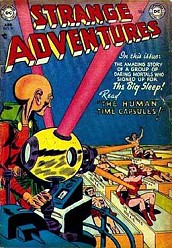 Lights, Camera -- Invasion! (1953) Writer: John Broome.
Art: Murphy Anderson. A teleplay about a Martian invasion of Earth
is taken over by real Martians. This tale refers to Orson Welles'
famous radio broadcast of "The War of the Worlds" (1938),
although not by name, and depicts a TV remake. It is related to
the many media stories Broome wrote for Strange Adventures.
This story takes place in the Golden Age of live TV. It is only
practical as a plot during a live broadcast.
Lights, Camera -- Invasion! (1953) Writer: John Broome.
Art: Murphy Anderson. A teleplay about a Martian invasion of Earth
is taken over by real Martians. This tale refers to Orson Welles'
famous radio broadcast of "The War of the Worlds" (1938),
although not by name, and depicts a TV remake. It is related to
the many media stories Broome wrote for Strange Adventures.
This story takes place in the Golden Age of live TV. It is only
practical as a plot during a live broadcast.
The exiting adventure elements in this story resemble Broome's classic "Raiders of the Waterless World" (Mystery in Space #56, December 1959). Both tales involve a solitary man who must single handedly prevent a surprise alien invasion. The man is engaged on peaceful, unrelated activities when the surprise attack occurs. In both stories, the hero has an off base approach to preventing the alien attack, something they do not expect.
Anderson's art is superb here. His depictions of the Martian spaceships
show excellent geometry. His depiction of Captain Comet in his
red uniform is also at his most macho. He also does a good job
with the Army officers here. These men fail, as they always do
in 1950's sf movies and comics! Our hero then has to take on the
aliens all by himself.
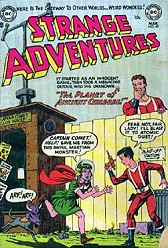 I Delivered Mail From Mars! (1954). Writer: Otto Binder.
Art: Mort Drucker. A mailman on contemporary Earth who is always
complaining about his hum drum existence finds one morning that
he has to deliver a letter from Mars that mysteriously appears
in the Post Office. Delicious comic tale, with a tongue in cheek
quality. The story has some of the same comic, whimsical feel
that Binder's Captain Marvel tales had had. Binder had just come
off a ten year stint on Captain Marvel. This story is perhaps
the first he wrote for DC's sf comics; it appears in the first
issue to which Binder contributed. Binder will be a prolific writer
for the magazines: nearly every issue of Strange Adventures
and Mystery in Space from 1954 to 1959 will feature at
least one Binder tale, often two or more. There is still perhaps
a touch of fantasy to all this: nothing about the Martians is
treated with raw scientific realism. Such a "science fantasy"
approach was typical of Binder's previous Captain Marvel work.
Later Binder stories for the DC sf magazines will find him much
more purely oriented towards science fiction. By the way, nearly
all titles of DC stories end with an exclamation point. I have
just treated this as a convention, and have usually stripped off
this exclamation point in these articles. But "I Delivered
Mail From Mars!" needs its ! to create its full comic effect.
The title is deliberately a bit exaggerated, a spoof of over-blown
science fiction stories.
I Delivered Mail From Mars! (1954). Writer: Otto Binder.
Art: Mort Drucker. A mailman on contemporary Earth who is always
complaining about his hum drum existence finds one morning that
he has to deliver a letter from Mars that mysteriously appears
in the Post Office. Delicious comic tale, with a tongue in cheek
quality. The story has some of the same comic, whimsical feel
that Binder's Captain Marvel tales had had. Binder had just come
off a ten year stint on Captain Marvel. This story is perhaps
the first he wrote for DC's sf comics; it appears in the first
issue to which Binder contributed. Binder will be a prolific writer
for the magazines: nearly every issue of Strange Adventures
and Mystery in Space from 1954 to 1959 will feature at
least one Binder tale, often two or more. There is still perhaps
a touch of fantasy to all this: nothing about the Martians is
treated with raw scientific realism. Such a "science fantasy"
approach was typical of Binder's previous Captain Marvel work.
Later Binder stories for the DC sf magazines will find him much
more purely oriented towards science fiction. By the way, nearly
all titles of DC stories end with an exclamation point. I have
just treated this as a convention, and have usually stripped off
this exclamation point in these articles. But "I Delivered
Mail From Mars!" needs its ! to create its full comic effect.
The title is deliberately a bit exaggerated, a spoof of over-blown
science fiction stories.
The hero of this tale undergoes experiences somewhat similar to those in Binder's transformation stories. In those tales, the hero gets super powers, or undergoes some personal transformation, such as becoming large or small. The hero of "Mail" does not undergo any physical transformation. But his contact with the letter from Mars affects him in a similar way as acquiring super powers does the transformation story heroes:
- He gets involved in a series of situations enabled by the letter.
- These situations show a great deal of variety.
- They tend to be pleasant, or at most only mildly frightening.
- They tend to be imaginative and interesting to the reader.
- Several times he has to solve challenges or problems posed by his new situation.
- His experiences tend to be mildly comic.
- The hero tends to be a bit of an Everyman, like Jimmy Olsen, or the mailman here.
- The transformation tends to get the hero involved with people with a specialized profession or hobby.
Mort Drucker would go on to fame with his delightful work for Mad Magazine. Here he shows that he might have had a successful career as a sf comic book artist.
52 (janv.1955) The Mystery of the martian canals
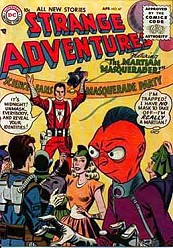 The Martian Masquerader (1956). Writer: John Broome. Art:
Gil Kane. A Martian comes to the offices of Strange Adventures,
and tries to sell a story about his own life. The frame tale in
the comics office is hilarious. The editor, Mr. Black, seems to
be a thinly veiled version of Julius Schwartz, and Broome gets
in some funny digs at him. Kane's version of Schwartz is less
flavorful and more normal looking than Sid Greene's many caricatures
of him. This is the earliest tale of which I am aware that features
the DC sf comics as characters in one of their own stories. As
is usual in such stories, the words "comic book" are
not mentioned. The books are treated simply as magazines or periodicals,
and the writers are "science fiction authors". There
is perhaps some issue of prestige involved here. Like most of
the subsequent tales, this one deals with a writer's attempt to
sell a story to Schwartz. Such sales attempts seem to be the central
nexus of the relationship between Schwartz and the writers.
The Martian Masquerader (1956). Writer: John Broome. Art:
Gil Kane. A Martian comes to the offices of Strange Adventures,
and tries to sell a story about his own life. The frame tale in
the comics office is hilarious. The editor, Mr. Black, seems to
be a thinly veiled version of Julius Schwartz, and Broome gets
in some funny digs at him. Kane's version of Schwartz is less
flavorful and more normal looking than Sid Greene's many caricatures
of him. This is the earliest tale of which I am aware that features
the DC sf comics as characters in one of their own stories. As
is usual in such stories, the words "comic book" are
not mentioned. The books are treated simply as magazines or periodicals,
and the writers are "science fiction authors". There
is perhaps some issue of prestige involved here. Like most of
the subsequent tales, this one deals with a writer's attempt to
sell a story to Schwartz. Such sales attempts seem to be the central
nexus of the relationship between Schwartz and the writers.
The office is full of large framed copies of covers of Strange Adventures; later tales showing Schwartz' office do not contain these. Perhaps this is a fantasy of Kane's to make the offices more colorful. It does visually convey the fact that this is the office of a comic book; if the covers were not there, this would look just like any typical American business office. Also, Kane was a frequent cover artist of the magazines; perhaps he is trying to show off his wares, and stress the importance of the covers in the magazine's work.
The Martian tale itself is routine. We see the whole life story of the hero, as is typical of Broome. Also typical is the way the Martian has left his own society, gone into exile in another, and is carrying out a program that is in radical opposition to his own societies' standards and mores.
The bird-like appearance of the Martians anticipates Kane's later
creation of Tomar-Re in Green Lantern.
The tale is based on a cover by Gil Kane, showing everyone about
to unmask at a "Science Fans Masquerade Party" - this
is perhaps like a typical real life sf fan party of the era, with
everyone dressed as spacemen or aliens. Kane does a good job with
the space suit of the man leading the party.
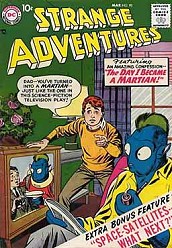 The Day I Became a Martian (1958). Writer: Otto Binder.
Art: Carmine Infantino. While going about his daily life on Earth,
a science fiction writer is repeatedly transformed into a Martian;
each time, a different one of his senses is put to the test, revealing
a different, unusual fact about Martian senses. Binder wrote a
whole series of tales for the DC sf comic books in the 1950's
dealing with first contact between aliens and Earthmen, and the
difficulties of communication between the two groups. Many of
these tales deal with perceptual difficulties that inhibit communication.
This story is one of the most straightforward. It concentrates
on the sensory differences themselves; it does not show actual
communication going on between Earthmen and Martians. Thus, it
takes place at an earlier stage of the Contact process than most
of Binder's tales on this subject. The tale has the serial construction
familiar in Binder, with a series of recurring events: each fresh
transformation reveals a different aspect of Martian senses. Some
Binder tales are set up as sf mysteries, with the reader challenged
to guess the hidden difficulties in communicating. By contrast,
in this story the reader knows about each fresh perceptual anomaly
immediately. There is no mystery plot.
The Day I Became a Martian (1958). Writer: Otto Binder.
Art: Carmine Infantino. While going about his daily life on Earth,
a science fiction writer is repeatedly transformed into a Martian;
each time, a different one of his senses is put to the test, revealing
a different, unusual fact about Martian senses. Binder wrote a
whole series of tales for the DC sf comic books in the 1950's
dealing with first contact between aliens and Earthmen, and the
difficulties of communication between the two groups. Many of
these tales deal with perceptual difficulties that inhibit communication.
This story is one of the most straightforward. It concentrates
on the sensory differences themselves; it does not show actual
communication going on between Earthmen and Martians. Thus, it
takes place at an earlier stage of the Contact process than most
of Binder's tales on this subject. The tale has the serial construction
familiar in Binder, with a series of recurring events: each fresh
transformation reveals a different aspect of Martian senses. Some
Binder tales are set up as sf mysteries, with the reader challenged
to guess the hidden difficulties in communicating. By contrast,
in this story the reader knows about each fresh perceptual anomaly
immediately. There is no mystery plot.
Binder loved tales about transformations. At first glance, this story falls into the transformation paradigm. Binder even has the sf writer-narrator cite Robert Louis Stevenson's The Strange Case of Dr. Jeckyll and Mr. Hyde (1886) as one of his favorite books. He is plainly speaking for Binder himself, and paying tribute to the source of Binder's many transformation stories. However, the story that unfolds here is different from Binder's usual transformation tales. Here the transformation is tightly focused on a single purpose: testing the hero's new Martian senses. The transformation seems purposive and deliberate. By contrast, in most of Binder's real transformation tales, the heroes' metamorphosis is an accident. He then proceeds to have a remarkably varied and diverse series of adventures, exploiting every possible application of his transformation to his life. The hero might join a circus, solve crimes, work puzzles, help out neighborhood kids, appear on television shows, or even clean out his cupboards or fix his auto with his new powers. This whole approach is absent in the current tale.
This is one of several Binder characters who is an sf writer; in this case as in others, he gets ideas for stories which turn out to be telepathic messages from another planet. The writer Rhett Mason is depicted with the extreme dignity and class with which authors were depicted in Hollywood movies. He smokes a pipe, a sign of intellectuality in the 1950's, and is obviously extremely intelligent. He shows considerable analytic skills, as well as being a creative person. He is the author of sf plays for television. The writers of the DC sf comic books must clearly have wanted to write for TV; they would have had much to contribute to the Golden Age of TV drama in the 1950's. However, as far as I know this never took place: I have never seen a single teleplay by any comic book author of that era. This seems like a huge pity.
The teleplay in this story is explicitly described as being in color. Color was still not common in 1958. It still had the air of being a high tech innovation, and perhaps this is why Binder specifies this. There are other possible reasons. Color has always been very important to the comic books; they had been in full color since the 1930's. So color would seem both natural and important to Binder. Also, the story shows glimpses of the teleplay, depicting blue Martians. The story then shows the hero turning into a similar blue Martian in real life. The effect is of illusion becoming reality. Had the show been in black in white, illusion and reality would have been different: the illusion of the TV show would have been in black and white, while the hero would have become a blue Martian in the real world. The effect of fantasy becoming reality would have been disrupted here.
Infantino depicts the hero as one of his elegant but middle class men. I do not know if he bears any resemblance to Binder himself. Mason's bookshelves include such titles as The Age of Reason and Space Science. When Infantino included a portrait of John Broome in "The Secret War of the Phantom General" (Detective Comics #343, September 1965), he similarly showed some books behind him.
"The Day I Became a Martian" (Strange Adventures #90, mars 1958) is about an author who is first contacted by aliens from another world through his TV set, then transformed by them into an alien himself.Secret of the Planetary Cones (1958)
art:
John Giunta
/ script:
Gardner Fox
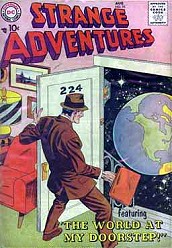 The Martian Barrier (1958). Writer: Gardner Fox. Art: Manny
Stallman. A barrier near Mars has prevented any Earth rockets
from going there; a pilot volunteers for the first manned space
flight to Mars. There are two Fox cycles in this tale: one involves
the destruction of unmanned rockets to Mars; the other cycle involves
the Martian scientist, his inventions and his relationship to
Earth. This tale is distinctive in that both cycles are associated
with bad guys, and are basically negative in their consequences.
The Martian scientist cycle involves one man and his special relationship
with two planets, Mars and Earth: in this it resembles Adam Strange's
cycle, and his unique relationship to Earth and Rann. However,
Adam Strange is a good guy, and the scientist is corrupt. The
Martian cycle holds a sort of magic mirror up to Adam Strange's
and suggests what would happen if Adam became corrupt, and started
exploiting his cycle for personal gain. Similarly, Sinestro is
a sort of dark parody of Green Lantern in John Broome's "The
Day 100,000 People Vanished" (Green Lantern
#7, juillet-août 1961), and shows what would happen if Hal Jordan
sped down the slippery slopes of corruption.
The Martian Barrier (1958). Writer: Gardner Fox. Art: Manny
Stallman. A barrier near Mars has prevented any Earth rockets
from going there; a pilot volunteers for the first manned space
flight to Mars. There are two Fox cycles in this tale: one involves
the destruction of unmanned rockets to Mars; the other cycle involves
the Martian scientist, his inventions and his relationship to
Earth. This tale is distinctive in that both cycles are associated
with bad guys, and are basically negative in their consequences.
The Martian scientist cycle involves one man and his special relationship
with two planets, Mars and Earth: in this it resembles Adam Strange's
cycle, and his unique relationship to Earth and Rann. However,
Adam Strange is a good guy, and the scientist is corrupt. The
Martian cycle holds a sort of magic mirror up to Adam Strange's
and suggests what would happen if Adam became corrupt, and started
exploiting his cycle for personal gain. Similarly, Sinestro is
a sort of dark parody of Green Lantern in John Broome's "The
Day 100,000 People Vanished" (Green Lantern
#7, juillet-août 1961), and shows what would happen if Hal Jordan
sped down the slippery slopes of corruption.
The Earth hero of this story has a familiar Fox role: he is the interrupter of the cycles. The fact that he is a human pilot, not an unmanned rocket, allows him to evade the Martian barrier of the title. This is pointed out explicitly by the story. Fox is always suggesting the value of individual people doing new and innovative things. The extra effort they put into something different often causes the problem facing a large group of people to be solved.
Manny Stallman shows a flair for architecture in this story. I
particularly liked the fountain, and the alien council room.
 The Martian Earth-Trap
(1959)
The Martian Earth-Trap
(1959)
written by Otto Binder
and drawn by Sid Greene.
In the year 2055, after Earth-based
space-salesman Wayne Morgan has his “spacemobile” refueled at a
Martian-run gas-station, he blasts off for Mars. But he soon discovers
that he’s under some sort of mental “spell” that forces him to
repeatedly alter his course back to Earth! Eventually, Morgan learns
that he’s been under the influence of “homing-gas” pumped into his
spacemobile by Zox, his friendly neighborhood gas-attendant -- and
member of the secret League Of Martian Monopolists. They plan to
blanket the earth with their homing-gas, which will prevent anyone from
leaving Earth, allowing Mars to gain a monopoly over all interplanetary
commerce! But Morgan turns the tables on Zox and soon leads (with the
help of a gas-effects-free co-pilot) an I.B.I. squad (that’s
Interplanetary Bureau Of Investigation) to Mars, where they round up
the Martian Monopolists. Later, back on Earth, Morgan laments that he
can no longer voluntarily leave Earth, but his boss promotes him to
Earth-bound “Executive Sales Director” and gives him a big bonus to
boot, allowing him to as the girl he loves to marry him. The only catch
is that his new bride has to drive them to their honeymoon resort on
Venus; otherwise, Morgan would keep returning their vessel right back
to Earth! Prisoner of The Undersea World!(1963)
Prisoner of The Undersea World!(1963)
Cover Artist(s): Pencilled by Gil Kane; inked by Joe Giella
This issue’s 9-page cover-story, “Prisoner OF The Undersea World!”,
written by Gardner Fox and, drawn by Sid Greene, is an unusual – even
Oddball -- tale that’s almost entirely told in captions, being a
flashback related by Commander John Marvin of the United States Navy.
When Tarkal, “the greatest scientist of his race” of frog-like rulers of
the undersea world pilots his pressurized craft to the ocean’s surface,
he unexpectedly encounters Cmdr. Marvin’s jet plane, which he
demolishes with his “bolt-gun”. Tarkal captures Marvin and hauls the
pilot and his wrecked plane to the ocean floor, where various froggy
scientists examine the surface-dweller. To determine Marvin’s
intelligence, they force him into a cage-match against a hammerhead
shark, but using a piece of coral like a knife, he emerges victorious.
Marvin’s subjected to a further battery of tests against other undersea
adversaries, but no matter how many he wins, his captors seem unaware of
his need for food and water. Using a spike from a poisonous giant
zebra fish, Marvin finally escapes back to the surface, where he’s
rescued by a search plane and helicopter. As Commander Marvin concludes
his story, it’s revealed that he’s telling it to his adult son Jim,
who’s about to embark on a mission piloting the first spaceship from
Earth to mars!
COMMANDER JOHN MARVIN:In the 8-page story “Prisoner Of The Green Planet!”
You never heard that story before, Jim – because it was hush-hush stuff. We tried – but failed – to locate that undersea city. And though the frogmen have never made another appearance here, we’ve been on the alert should they invade us again! When on mars, Jim, you too will find alien life-forms – though you may not recognize them as such! Learn from my experience – bear in mind what happened to me when I was removed from my natural habitat – Any life-form – taken from its environment and in danger of losing its life as I was from thirst and starvation – will fight back! Don’t ever forget it – from the moment you set foot on mars!CAPTION:
For the thrilling sequel to this undersea adventure, turn to the next story in this issue – as spaceman Jim Marvin encounters an incredible Martian form of life that wages a strange battle for survival against its human captors!
(“A Sequel To ‘Prisoner Of The Undersea World!’”), written by Gardner Fox and drawn by Murphy Anderson.
Astronavigator Colonel James Marvin, along with biochemist Professor Peter Struthers and geophysicist Dr. Abner Rawlings, flies the Mariner XXI on “Project Sherwood”, landing in the Syrtis Major area of the planet Mars. Discovering and collecting a variety of Martian lichen and rocks, they begin their trip back to Earth. During the flight, they discover that many of the lichens seem to be dying! That’s when the team discovers that the brain-shaped white rock is alive! Back on Earth, Jim uses the wisdom imparted to him by his father to observe “Rocky” the “brain-rock” – and determines that the organism is not only alive, it’s intelligent, too! Then, one night about a week after the Martian “brain-rock” has been on Earth, a massive power blackout affects the city, during which, the Mariner takes off with “Rocky” as its sole occupant! Here’s Jim’s lengthy explanation:
JIM MARVIN:
ROCKY, the MARTIAN, is indeed an intelligent life-form! So it must need “food” to exist – as my Dad did in the undersea world! My theory is -- ROCKY gets its “food” from the lichens, by absorption…When the lichens grow strong and green the “ROCK” automatically wakes from a hibernation sleep and begins absorbing the life-giving properties of the lichens…The lichens – drained of “food” and turned brown – now “sleep” as ROCKY lives! After a period of time, ROCKY goes back to sleep to give the lichens a chance to grow green-food again! This accounts for the Martian “canals” (beds of lichens) turning green and brown in a regular cycle…Ages ago, Mars had more of an atmosphere, and this means electrical storms. ROCKY and his fellow rock life-forms absorbed this electrical energy to move about…First ROCKY proved to itself that it could move my absorbing our electric energy – remember what happened when the lights first went out. Then, building itself up for a massive effort, it absorbed the entire city’s electric energy – enabling itself to fly to the spaceship – and using the rest of its absorbed energy to fly the ship back to MARS! Just as my Dad managed to steal away in the frog-men’s undersea vehicle – by watching how they maneuvered it – so did ROCKY! It was a battle for survival – and in each case, the alien prisoners won! When we go back to MARS some day – we must convince ROCKY and its fellow beings we made a mistake, that we didn’t mean any harm!
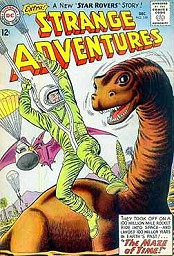 Yes Virginia -- There is a Martian
(1963). Writer: Gardner Fox. Art: Carmine Infantino. A little
boy keeps telling his skeptical parents about the very nice Martian
he's met in the woods. This gentle, upbeat tale milks the "what
an imagination Junior has" situation for some classic comedy.
The title refers to a famous real life newspaper editorial, "Yes
Virginia -- There is a Santa Claus".
Yes Virginia -- There is a Martian
(1963). Writer: Gardner Fox. Art: Carmine Infantino. A little
boy keeps telling his skeptical parents about the very nice Martian
he's met in the woods. This gentle, upbeat tale milks the "what
an imagination Junior has" situation for some classic comedy.
The title refers to a famous real life newspaper editorial, "Yes
Virginia -- There is a Santa Claus".
Young boys showed up several times in Fox's tales. They seem to be stand-ins for the youthful readers of the comic books. Fox always depicts them as innocent, naive, but courageous young people with a yearning for adventure, and a willingness to get involved and help out when the heroes of the story need assistance. Often times they play a key role in rescuing the hero at the end of the tale. The kids have a fondness for gadgets as well: Fox usually depicts them as mechanically inclined, and proficient at the use of various hand held toys: a facility that always winds up playing a role in the plot. The kids like to dress in "hero" costumes, such as cowboys or spacemen, and show a tendency towards hero worship. The parents of the kids are always depicted as nice people, caring and loving. The kids are not at all smart alecky. But they sometimes come up with very good ideas that turn out to be practical and useful. Fox included a young boy in the Adam Strange tale "The Multiple Menace Weapon" (Mystery in Space #72, December 1961); there are some thematic links between that story and "Virginia".
The Martian in this story turns out to look just like Earth humans. This is rare in sf comics. One suspects it is designed to make him look less frightening: during this era, horror material was considered as inappropriate to mix with children, rightly so in my judgment, and Fox and Infantino have taken pains to make this story as un-frightening and upbeat as possible. Instead of horror, it is filled with science fiction material. The Martian eventually tells a long sf history of his planet. This involves duplicate worlds: Fox often included doubles in his stories, and here he has come up with the idea of duplicate planets. Just as Fox sometimes extended the protagonists of his cycles from single people to mass populations, even whole worlds, here he has extended his idea of doubles to take on an entire solar system.
The Case of the blonde Bombshell (Star Hawkins) (1965)Star Hawkins is hired by the beautiful Lulu Lacey to retrieve some letters from Mars. Ilda is convinced that Lulu is a crook, but Star is too lovestruck to see it. Ilda follows Lulu back to a spy ring. She learns that Star is actually retrieving martian defense plans. When Star returns, Ilda swtiches the plans before he can hand them over to Lulu. When the spies find out they attack Star. He beats a pair that jump him at the office, then he raids their hide-out. Lulu helps Star beat the last of the spies, as she is really a government agent. She apologizes for using Star, but she was unable to tell him the truth.
All characters mentioned or pictured are ™ and © DC Comics, Inc. All Rights Reserved.
Accueil / Bulles de Mars / Plan du Site
